

If you are wondering about training for foreigners, how about planning an event with flower arrangement as the keyword?
I would like to recommend flower arrangement as a good choice for leadership training and team building for foreigners.
The reason for this is that in flower arrangement, you can acquire the ability to make decisions, gain insight, select the right person for the right job, and organize the whole team through the act of arranging flowers.
This keyword was also important among the warlords of the Warring States period, and flower arranging was a favorite pastime of the warriors.
And it is also a necessary skill for business people today.
In this issue, we would like to introduce leader training and team building for foreign employees using flower arrangement and ikebana as a subject matter.
・What is flower arrangement and ikebana?
・What is the connection between leadership training and ikebana?
・What is the connection between leadership training and ikebana?
We would like to know about actual examples of ikebana leader training.
Please read this article and get the information you need to choose an ikebana experience for your foreigner training program.
What is kado and ikebana?
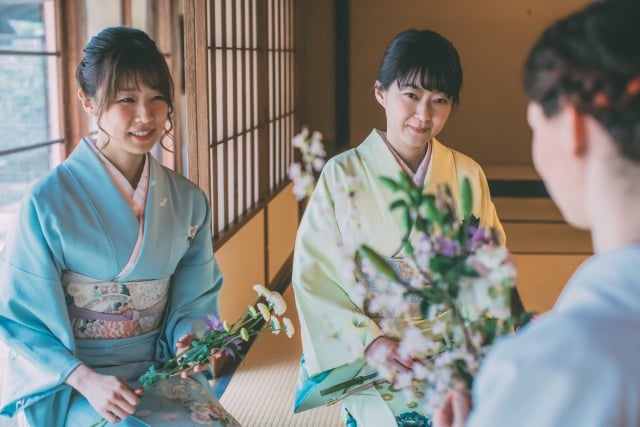
What is Ikebana?
Ikebana is the art of arranging plants, trees, and flowers in vessels for appreciation.
As a comparison with Western flower arrangement, flower arrangement is said to be appreciated from all angles (360°), while ikebana is said to be arranged to appreciate flowers from the front.
Japanese ikebana is said to be an art of “subtraction” to show space.
What is important in ikebana is said to be the “blank space,” and it is possible to appreciate the uniquely Japanese art of “ma” (space in between).
Another unique aspect of this art form is the use of not only flowers, but also all plants, including large branches, trunks, leaves, moss, nuts, and berries, as floral materials.
Many of the vases and utensils used in ikebana are uniquely Japanese and look even better in Japanese architecture, allowing the viewer to experience traditional Japanese culture firsthand.
The colors and textures of the flowers and the sense of the seasons are important in ikebana, so you will be able to deeply appreciate the seasons of spring, summer, fall, and winter.
It is a practice that can be started casually by people of all ages and both genders, and is enjoyed by Japanese people today.
Reference site: Ikenobo official website
What is Kado?
Kado is the art of flower arranging. The character for “way” in the word “do” means that through repeated practice and training, it is required not only to entertain guests, but also to face oneself and grow.
It is said to have a history of 550 years, and until the Edo period (1603-1867), it flourished within the samurai culture and was considered a favorite pastime of the samurai.
Kado is an art form that originated in Japan, where plants were erected and dedicated as “yorishiro” to invite the gods. It is said to originate from this trend.
It is said to have originally started as a way of arranging flowers for the gods and Buddha, but the prototype that is close to the present form was created in the middle of the Muromachi period (1333-1573).
The background of this style is the tokonoma, a space in the shoin-zukuri style of architecture that was popular among court nobles and samurai at the time.
Porcelain and paintings imported from China began to be displayed in the alcove, and live flowers, plants, and trees were added to match the porcelain and paintings, evolving into the current form.
At the time, flowers arranged by a monk at Rokkakudo temple in Kyoto became the talk of the town, and the monk lived by a pond, giving birth to the founder of Kado, called “Ikenobo.
From this point on, Kado continued as the manner of the samurai and the tastes of the warrior class until the Edo period (1603-1868).
Many schools of ikebana were born, and the art has continued to the present day.
Kado, which had flourished as a favorite of the samurai class, became a popular practice for women as part of their training as brides after the flowering of civilization.
Today, ikebana is also attracting attention for team building and other human resource development purposes, and more and more men are taking up ikebana as well.
spirit of Kado
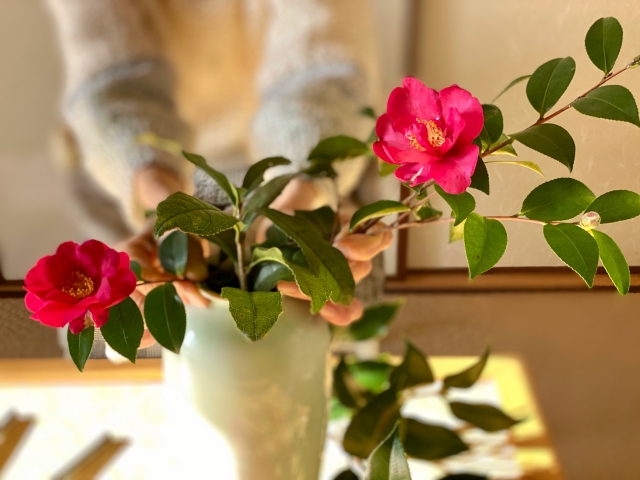
In the Warring States period, Kado, or ikebana, was said to be one of the preferences of samurai warriors, and men were often the main flower arrangers in ancient times.
Kado is said to be an aesthetic of subtraction, the exact opposite of Western flower arranging, which requires arrangements that fill the entire space.
Flowers are arranged as they would be in nature, utilizing the space available to them.
Kado teaches the minimal use of plants, trees, and flowers, and the use of the beauty of flowers as they naturally exist in the space, even with human intervention.
Therefore, the beauty of flowers is accentuated by trimming unnecessary branches and leaves to the extreme.
In Kado, as in the phrase “the right person in the right place”, we are constantly making decisions to select the right state of floral materials for the right occasion while creating a work of art.
This was considered an important preference of samurai warriors because it cultivated “decisiveness” and “judgment” and also required “insight” to see the whole picture.
This is one of the reasons why Kado is a perfect training program for leaders.
Kado was enjoyed by warlords

Until the Edo period (1603-1867), Kado was the status quo of samurai society.
In the Warring States period in particular, there are records of how even famous shoguns in history enjoyed Kado and practiced ikebana on a daily basis.
Reference site: Ikenobo Ikebana School “Warlords and Ikebana”
Against this background, generals of the Shogun class were constantly faced with the question of how to effectively fight and achieve war results with the forces, weapons, and land they had at their disposal. This is said to be because generals always faced the question of how to fight effectively with their own troops, weapons, and land.
Oda Nobunaga, one of the generals who loved flower arrangement, is said to have always arranged flowers before a major battle.
In Kado, when arranging flowers, the artist makes a series of decisions with great vigor.
A moment’s hesitation over which container to use or which branch to cut will prevent the flowers from being used to their full potential.
The skill of the artist is tested by how beautifully he or she can express the flowers using the flowers, vases, and tools at hand.
This is also true for today’s businesspeople.
They repeatedly make the best decisions under any circumstances.
We can see what is required of today’s leaders in the military commanders of the Warring States period.
Against this background, Kado spread as an important “way” in the warrior society.
What is Leader Training and Team Building?

What is leadership training?
Leader training refers to training for project leaders, managers, mid-level employees, and other employees who will be performing their duties.
The objective is to learn the skills that are important for leading an entire team, and an attempt is made to discover the skills that are lacking through the training.
Most people who need leadership training are those who have already started their careers or have been with the company for a certain number of years.
Then there are cases where we target people who have just joined the company but want to be selected as leaders in terms of human resources.
Leader training is also effective for those who are beginning to be selected to launch new projects and serve as leaders.
What is required of them is the ability to lead a team, communication skills, and the ability to train subordinates and make decisions.
For this reason, more and more companies are offering leader training through team building as well as practical leader training to improve work skills.
For this reason, training is provided to develop leaders.
Reference site: Human Resource Development Column
What is a simple explanation of team building?
Team building is aimed at the goal of creating a team that maximizes individual skills and abilities to achieve a single goal.
The purpose of this is to build a team and to better define the team’s goals and the roles of each member.
The goal is to build a team that can achieve its goals by maximizing the skills, abilities, and experience of each team member.
Currently, many companies are facing problems such as “capable but not 100% effective” and dissatisfaction with the relationships among staff members and the team structure.
For example, if one leader simply executes what he or she unilaterally tells the members to do, the team’s performativity will decrease.
What is essential is for each member to achieve the goal through interaction, while exerting his or her maximum strength.
Team building is especially effective when a team is not functioning as a team, even though there are many talented people working together.
Recommended Related Articles: Japanese Culture|Six recommended training and team building programs for foreigners: Kado, Tea Ceremony, Karate, Sumo, Sushi, and Taiko!
What is important when training foreign employees

In response to population decline and globalization, an increasing number of companies in Japanese society are accepting foreign employees.
However, many employers are still confused when hiring non-Japanese employees because of cultural and customary differences.
This is not to say that there are not companies that are at a loss to hire foreign employees due to the fear that cultural and customary differences will cause problems when performing their duties.
However, it is important to bring in talented people into a company, and nationality is not a reason to hesitate to hire them.
This is why it is necessary to educate foreign employees who have joined the company.
Training and team-building programs are planned to provide foreign employees with the necessary skills to work in a Japanese company, as well as job descriptions.
This is because many new foreign employees have not yet mastered the skills of “reading the situation and sensing the atmosphere,” which are said to be particularly difficult in Japanese customs, and the business manners of Japanese society.
In addition, some foreign employees are currently unable to form a good team with other Japanese employees due to language insecurity and lack of communication, which may lead to isolation.
In such cases, team building and training can be expected to be an opportunity for them to find meaning in their presence in the company.
Recommended related articles: Inbound Support! Martial Arts Experience, Entertainment, Team Building
Kado and Ikebana leadership training and team building
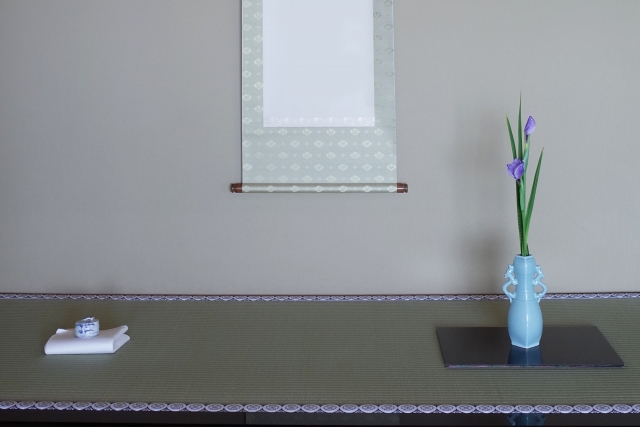
What is Kado and Ikebana Leader Training?
Leaders are required to have the ability to lead and communicate with their team members in order to bring them together and achieve 100% or more results, as well as the ability to nurture their subordinates and make good decisions.
Reasons why Kado is suited for leader training include
・The continuum of decisiveness and judgment
・Insight to see the right person in the right place
・Imagination and creativity
Kado is a way to make the floral materials in front of you more beautiful by adding human touch. It is necessary to always make appropriate judgments while imagining the future.
It is also an art form that uses all five senses, and therefore helps to alleviate stress.
For these reasons, Kado and ikebana are very suitable for leadership training.
What is team building in Kado and Ikebana?
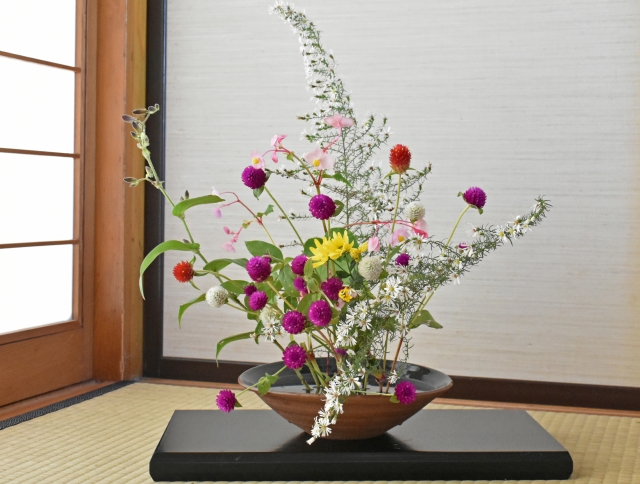
In team building, the process of creating one work of art together is very important.
This is because the process of working together to create something, rather than just discussing it, will help build team power, and will also help participants discover the importance of mutual respect and courtesy.
The key word is not to receive an overview of ikebana from the instructor, as is the case in ikebana classes, but to work together to create a single work of art.
You will be required to accept your own opinions and those of others as you work as a team, trusting each other’s judgment, insight, and decision-making skills.
These interactions with each other also reveal the elements that make us function as a team in a cyclical manner.
And because it is an art form that is created while actually touching a living plant with your hands, a great deal of mental action is expected as well.
Advantages of choosing Kado and Ikebana for foreigner training and team building
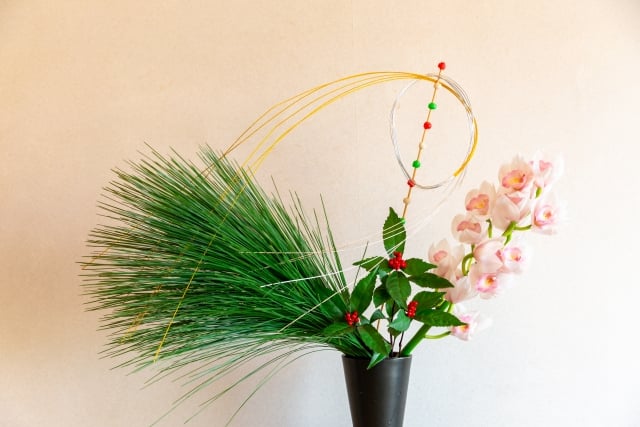
Training programs for foreigners based on Japanese cultural experiences are becoming increasingly popular.
This is due to the unique Japanese ideology that traditional Japanese culture embraces.
Many aspects of Japanese culture and thought include a sense of courtesy toward all things in the universe and respect for others. This is an important issue in various business situations.
In addition, Japanese culture is not only about fulfillment, but also about truths that can sometimes be seen by drawing back, and this interest in ideas that are not often seen in Western culture is attracting attention from abroad.
This is the reason why training for foreigners and team building based on Japanese culture with this background are necessary and important points for foreign employees to gain when forming a team within a company.
It is a keyword that I highly recommend, especially for foreigner training, because it includes such content and also allows you to experience the ideology of Japanese culture.
Kado and Ikebana Leadership Training Cases
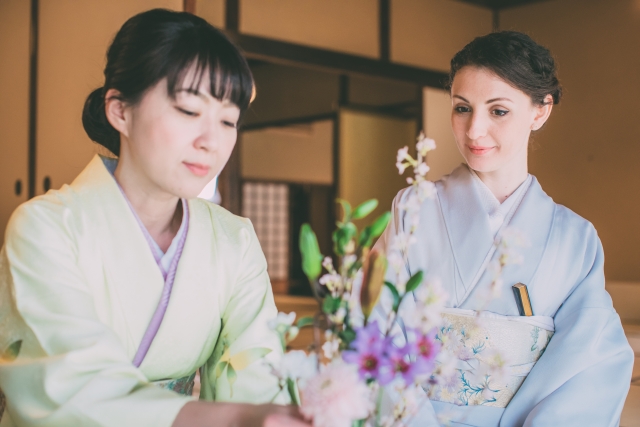
Let us introduce an example of a major company that actually used ikebana for foreign leader training.
A major Japanese company, which is active on the world stage, asked us about leadership training for their foreign employees.
When we recommended the Kado leadership training program, they were very interested in it, and we immediately put it into action.
First, the leaders of each department of the new project gathered together. Most of them were newly selected members who were experiencing leadership for the first time.
First, they learn about Kado and ikebana from the instructor, and then learn the basics of ikebana, such as how to cut leaves and how to balance the arrangement.
Unlike flower arrangements, ikebana is not about making flowers look beautiful by the number or volume of flowers, but rather about arranging a few flowers and branches while considering the balance between the floral materials and space.
Therefore, the students seemed to be at a loss at first because they had to cut leaves and branches well to finish the work.
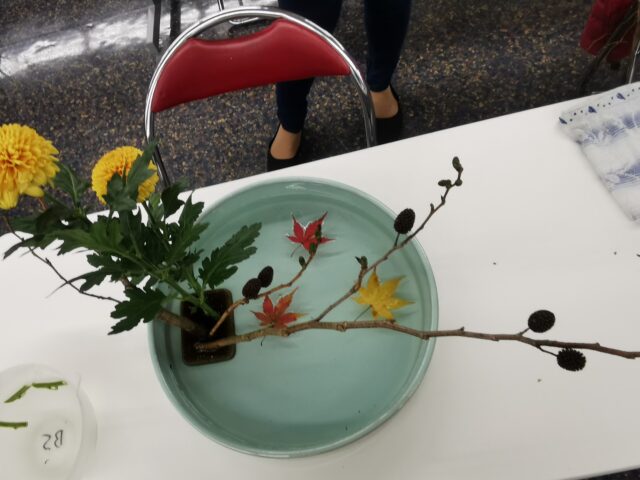
However, as they became more and more accustomed to the process, the color of their eyes began to change, and with a strong sense of concentration, they began to make decisions based on their own intuition.
In the silent hall, only the sound of scissors echoed through the air.
At the end of the workshop, everyone was invited to critique their work.
First, one by one, the participants present what they focused on and how they wanted to express themselves.
Then we critique each other’s work. By doing so, they can calmly look at their own and others’ judgments, and train to analyze and put into words the good points.
In this way, the training for foreign leaders in Kado came to an end.
Everyone was quite excited by their first experience! They said it was their first experience.
On the way home, they seemed to enjoy talking with each other more than when the training started.
Ikebana is chosen for leader training because it is expected to stimulate creativity, including judgment, insight, and decisiveness.
summary

How was it?
In this issue, we have introduced Kado and leadership training as keywords, along with examples.
One of the reasons why military commanders in the Warring States period practiced Kado is that it was a way to focus the mind and also a way to train the ability to make decisions and to sharpen insight.
Through Kado, one can learn to make decisions based on one’s own intuition.
If you are worried about leadership training, Kado leadership training is what we recommend.
If you are worried about leadership training or team building for foreigners, please feel free to contact us at Motenas Japan.

We are working day and night to spread Japan’s unique hospitality culture to people around the world. Please feel free to contact us for any inquiries regarding the reception and hospitality of guests visiting Japan.


